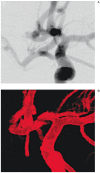Cerebral arterial fenestrations
- PMID: 24976087
- PMCID: PMC4178766
- DOI: 10.15274/INR-2014-10027
Cerebral arterial fenestrations
Abstract
Arterial fenestrations are an anatomic variant with indeterminate significance. Given the controversy surrounding fenestrations we sought their prevalence within our practice along with their association with other cerebrovascular anomalies. We retrospectively reviewed 10,927 patients undergoing digital subtraction angiography between 1992 and 2011. Dictated reports were searched for the terms "fenestration" or "fenestrated" with images reviewed for relevance, yielding 228 unique cases. A Medline database search from February 1964 to January 2013 generated 304 citations, 127 cases of which were selected for analysis. Cerebral arterial fenestrations were identified in 228 patients (2.1%). At least one aneurysm was noted in 60.5% of patients, with an aneurysm arising from the fenestration in 19.6% of patients. Aneurysmal subarachnoid hemorrhage or non-aneurysmal subarachnoid hemorrhage were present in 60.1% and 15.8%, respectively. For the subset of patients with an aneurysm arising directly from a fenestration relative to those patients with an aneurysm not immediately associated with a fenestration, the prevalence of aneurysmal subarachnoid hemorrhage was 66.7% vs. 58.6% (p = 0.58). Fenestrations were more often within the posterior circulation (73.2%) than the anterior circulation (24.6%), though there was no difference in the prevalence of aneurysms within these groups (61.1% vs. 60.7%, p = 1.0). Cerebral arterial fenestrations are an anatomic variant more often manifesting at the anterior communicating arterial complex and basilar artery and with no definite pathological relationship with aneurysms.
Keywords: anatomy; aneurysm; fenestration; stroke; subarachnoid hemorrhage.
Figures





References
-
- Dey M, Awad IA. Fenestration of supraclinoid internal carotid artery and associated aneurysm: embryogenesis, recognition, and management. World Neurosurg. 2011;76(6):592–e1-5. doi: 10.1016/j.wneu.2011.04.019. - DOI - PubMed
-
- Bożek P, Pilch-Kowalczyk J, Kluczewska E, et al. Detection of cerebral artery fenestrations by computed tomography angiography. Neurol Neurochir Pol. 2012;46(3):239–244. doi: 10.5114/ninp.2012.29132. - DOI - PubMed
-
- Arráez-Aybar LA, Villar-Martin A, Poyatos-Ruiperez C, et al. Prevalence of fenestrated basilar artery with magnetic resonance angiography: a transversal study. Surg Radiol Anat. 2013;35(6):487–93. doi: 10.1007/s00276-012-1053-5. - DOI - PubMed
-
- Bayrak AH, Senturk S, Akay HO, et al. The frequency of intracranial arterial fenestrations: a study with 64-detector CT-angiography. Eur J Radiol. 2011;77(3):392–396. doi: 10.1016/j.ejrad.2009.09.015. - DOI - PubMed
Publication types
MeSH terms
LinkOut - more resources
Full Text Sources
Other Literature Sources
Medical

